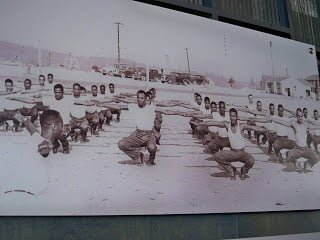The cadets in the Tuskegee-based flight training program were all black men. However, like their white counterparts at other flight training facilities of the time, they were also “green” when it came to flying for the U.S. military.
The training program at Tuskegee was designed to turn them into combat-ready pilots. The record of the Tuskegee Airmen proves that the program did its job.
For the cadets, part of their program included getting into good physical shape. The aircraft used in WWII required strength of mind and body to fly. Many of the cadets were not in fighting trim when they arrived and during preflight training, half of their time was spent in physical conditioning!
The other half of their day while in preflight was spent learning the basics of wartime flying: flight theory, navigation, radio procedures, physics and aircraft identification. The cadets had to be able to identify the airplanes flown by the Allies, too. The Tuskegee Airmen National Historic Site curators recreated a classroom as it was set up to teach the cadets, complete with narration that starts when a visitor enters the room. These airplane silhouettes were hung from the ceiling. See any you recognize?
Coca Cola got into the act (that’s a P40-F Warhawk with stats at the bottom).
Instruction was very detailed – even the uniforms that German military personnel wore were studied.
The cadets also needed to be mentally prepared to go to war. In their new line of work, they were going to kill other human beings. There was also the possibility that they could be killed, too. Any way you look at it, that’s a big mental adjustment to make. The flight program included “Know Your Enemy” lessons.
 |
| Red area is USSR and its allies, blue are western Allies, and black are Axis countries, including Vichy France. |
They also had to learn about America’s Allies.
Daily and weekly news publications that covered the Allies’ war efforts were displayed on bookstands in public areas, along with war-related books and pamphlets. The cadets were strongly encouraged to read them regularly in order stay up to speed with how the war was going. It was also a subtle way to get them thinking like warriors.
Once preflight instruction was complete, flight instruction started. At the Site, the curators have also recreated a Cadet Waiting Room, complete with narration so visitors can understand what they are seeing. Cadets would wait for their flight instructors in this room.
Airplane assignments and weather updates were listed on the board.
Flight maneuvers were outlined on the board, too.
The cadets talked among themselves about flying in that room and everywhere else.
Each pilot had to gain enough flight proficiency to solo and then ultimately complete a cross-country flight before he could graduate from primary flight instruction at Moton Field. After graduation, the pilot moved on to secondary flight instruction at Tuskegee Army Air Field (TAAF). In all, 966 cadets received their wings at Moton.
This 3-part series only touched on some of what I saw on a visit to the Tuskegee Airmen National History Site last month. I would encourage you to experience it for yourself if you’re ever in central Alabama. Admission is free and satisfaction is certain.
Where’s the Traveling Exhibit These Days?
The RISE ABOVE Traveling Exhibit is finishing up a visit to the Cavanaugh Flight Museum in Addison, Texas. It will be there today and tomorrow; hours are 9-5.
The Traveling Exhibit will next be appearing at the New Smyrna Beach (Fla.) Balloon and Sky Fest April 5-6. The rig and Mustang were there last year and were hugely popular. I was still living in Florida at that time and helped welcome and register visitors. They put on a fun show and we hope to see you there.
The CAF Red Tail Squadron is volunteer-driven 501c3 organization that operates as part of the Commemorative Air Force. For more information about the Squadron and its educational mission, visit www.redtail.0rg.
www.redtail.org
















